Leonard Arthur French
Flight Lieutenant RAF
1923 - 1944
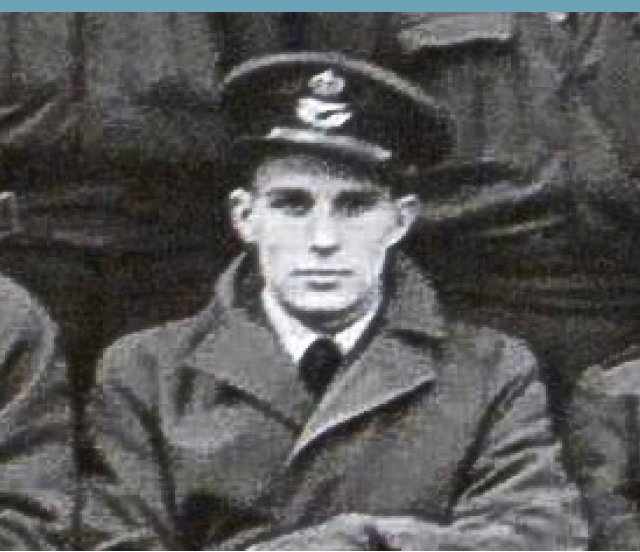
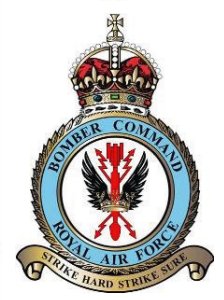 |
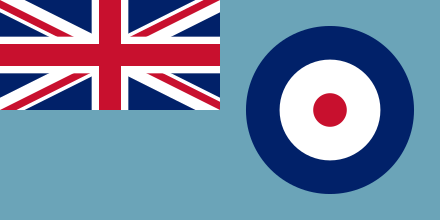 |
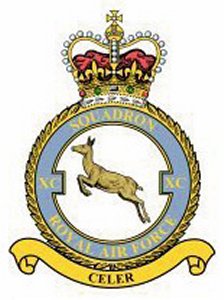 |
THE MISSION
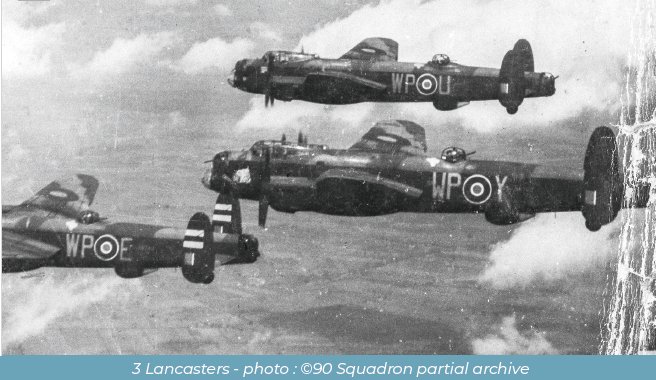 Flight Lieutenant Leonard French took off from the airfield at 90 Squadron RAF Tuddenham (Suffolk) at 21h35 on 7 August 1944 to bomb a German strong point in the Normandy battle zone. He and his crew were flying in a four-engined Avro Lancaster bomber LM111 WP-G as part of Operation Totalize, whose purpose was to bomb troop concentrations near Falaise, ahead of advancing Allied ground troops. The operation by 90 Squadron was part of a bomber force numbering 1019 aircraft of which 10 were lost.
Flight Lieutenant Leonard French took off from the airfield at 90 Squadron RAF Tuddenham (Suffolk) at 21h35 on 7 August 1944 to bomb a German strong point in the Normandy battle zone. He and his crew were flying in a four-engined Avro Lancaster bomber LM111 WP-G as part of Operation Totalize, whose purpose was to bomb troop concentrations near Falaise, ahead of advancing Allied ground troops. The operation by 90 Squadron was part of a bomber force numbering 1019 aircraft of which 10 were lost.
After releasing its bombs, their Lancaster was hit by anti-aircraft fire and may also have sustained damage from a Messerschmitt Bf 110 night fighter. Flight Lieutenant French kept the aircraft steady long enough to enable the rest of the crew to bale out. LM111 WP-G crashed at Clarbec in a field next to the chemin de la Galoche, where a propeller blade and parts from the aircraft mark the spot. The pilot remained at the controls and is buried in a Commonwealth War Grave in Clarbec church cemetery. The inscription on his gravestone reads: “Glorious in life, so magnificent in death, ever with us, Dad, Mum and Irene.”
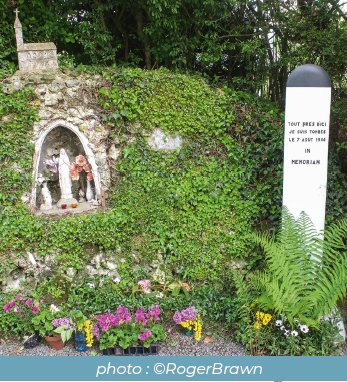 Flying Officer George Leslie Smith, the Lancaster’s navigator, wrote in his evasion report that after they had bombed the target, they were hit by flak (Flugabwehrkanone) near Le Havre. The port inner engine was set on fire and the pilot gave the order to abandon the aircraft. Six members of the Lancaster’s crew were able to bale out:
Flying Officer George Leslie Smith, the Lancaster’s navigator, wrote in his evasion report that after they had bombed the target, they were hit by flak (Flugabwehrkanone) near Le Havre. The port inner engine was set on fire and the pilot gave the order to abandon the aircraft. Six members of the Lancaster’s crew were able to bale out:
Flying Officer David Reid RCAF (bomb aimer) J25533 - age 31
Flying Officer George Leslie Smith (navigator) 156347 - age 29
Flight Sergeant Howard McNeill Kiddie RCAF (mid-gunner) R203424 - age 19
Sergeant Charles Gold (rear gunner) 1458498 - age 21
Sergeant William John Henderson (flight engineer) 2202738 - age 25
Sergeant Denis Bernard Cassell (radio operator) 1473875 - age 20
(RCAF: Royal Canadian Air Force).
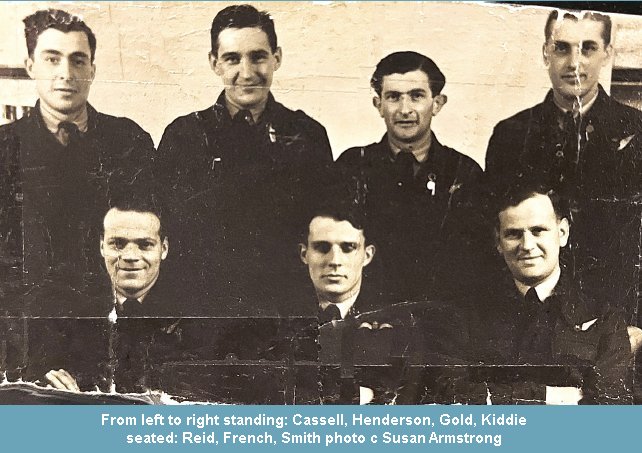 Cassell and Reid were captured and became prisoners of war but the others succeeded in evading capture and with the help of local people made contact with advancing British troops.
Cassell and Reid were captured and became prisoners of war but the others succeeded in evading capture and with the help of local people made contact with advancing British troops.
The entry in 90 Squadron’s operations record book reads:
“7.8.44 - 21 aircraft were detailed and prepared to attack Mare de Magne. 2 aircraft failed to return from these operations. 19 aircraft attacked primary [target] between 2339 and 2349 hours from 8000 to 7000 feet dropping 22 x 1000 S.A.P. [semi-armour piercing] and 57 x 500 GT TD [time-delay] bombs. Weather was clear. All aircraft bombed the red T.I.s [target indicators] on the instructions of M.B. [the master bomber] who moved the AP [aiming point] gradually as the attack progressed. All crews agreed that the bombing was concentrated around the AP [aiming point]. Some flak was encountered and fighters were active amongst the later aircraft on way home.”
AFTER THE CRASH
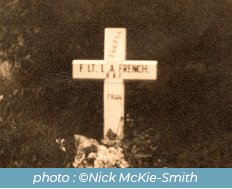 Having remained at the controls of his aircraft - presumably in order to enable his crew to bale out - Flight Lieutenant French was killed when his damaged Lancaster crashed. On 8 August, the day after the crash, the mayor of Clarbec, M. Rémy Lecachey, gathered up French’s remains for burial in the graveyard of the village church.
Having remained at the controls of his aircraft - presumably in order to enable his crew to bale out - Flight Lieutenant French was killed when his damaged Lancaster crashed. On 8 August, the day after the crash, the mayor of Clarbec, M. Rémy Lecachey, gathered up French’s remains for burial in the graveyard of the village church.
On the same day (8 August 1944) Wing Commander A.J.Ogilvie, officer commanding 90 Squadron, wrote to Flying Officer Smith’s wife and the next-of-kin of the other crew members to say that they were missing, adding:
“Your husband was detailed to carry out an important raid against the enemy and his aircraft failed to return. No word has been received from the aircraft up to the time of writing and any further news received will be immediately communicated to you.”
“Your husband will be a great loss to the squadron, where he has always carried out his duties in a conscientious and exemplary manner and on behalf of myself and all members of the squadron, I would like to offer you our sincere sympathy”.
With his letter Wing Commander Ogilvie included the names of each crew member’s next-of-kin and offered to forward any letters. As a consequence, Flight Lieutenant French’s father on 12 August 1944 wrote to Mrs Smith asking her to inform him if there was any news of the crew and added:
“My dear son has always spoken most highly of the devotion and skill of all members of the crew of the aircraft and I am certain that if by any fortunate chance an opportunity to save the crew did present itself, you may rest assured that this was not missed.”
ESCAPE AND EVASION REPORTS
After reaching British lines the four escapers Smith, Kiddie, Gold and Henderson were interviewed by MI9 - Directorate of Military Intelligence, section 9 - (whose task was to create escape and evasion lines for airmen shot down or trapped behind enemy lines). Their evasion reports are interesting in that they demonstrate the level of help which RAF personnel received from local people in occupied France and in particular in Clarbec and the surrounding area. They also highlight the risk which those airmen took in making themselves known and asking for help.
The two crew members who did not manage to escape were taken prisoner by German soldiers stationed in Clarbec village.
Smith ![]()
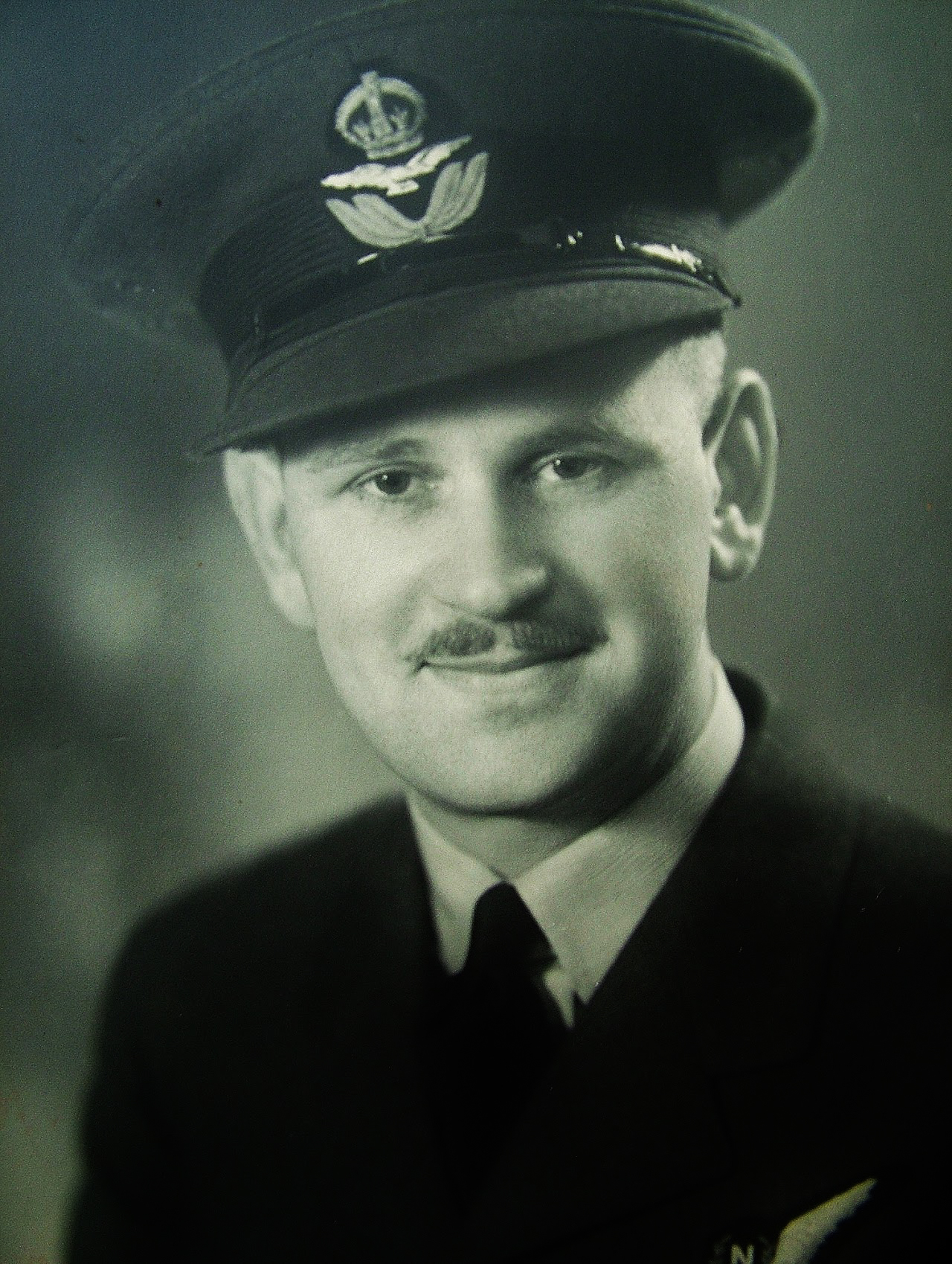
I baled out at 2350 hours on 7 August and landed in an orchard near St Hymer. I hid my parachute, harness and mae west in a ditch and walked north-west for approximately four miles and hid in a hayloft until 2200 hours on 9 August when I began walking south-west. At 0430 hours on 10 August I approached a farm where I asked for help. I was told to continue south as Germans were billeted nearby.
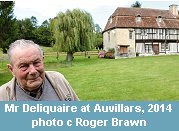 Flying Officer Smith found refuge at the Manoir du Bois-Simon at Auvillars, near Bonnebosq where, after deciding to venture out of the barn where he was hiding, he was concealed by one of the manoir’s employees, Roland Deliquaire, in a space on the second floor. He remained there from 11-22 August despite the fact that 25 Germans were billeted at the farm from 17-19 August. When a section of the advancing King’s Own Yorkshire Light Infantry came across the two men in the woods, they began shooting, wounding Roland Deliquaire in the leg. As Smith and Deliquaire took cover, in his best British officer accent George shouted “Cease fire you bloody idiots!”
Flying Officer Smith found refuge at the Manoir du Bois-Simon at Auvillars, near Bonnebosq where, after deciding to venture out of the barn where he was hiding, he was concealed by one of the manoir’s employees, Roland Deliquaire, in a space on the second floor. He remained there from 11-22 August despite the fact that 25 Germans were billeted at the farm from 17-19 August. When a section of the advancing King’s Own Yorkshire Light Infantry came across the two men in the woods, they began shooting, wounding Roland Deliquaire in the leg. As Smith and Deliquaire took cover, in his best British officer accent George shouted “Cease fire you bloody idiots!”
Kiddie ![]()
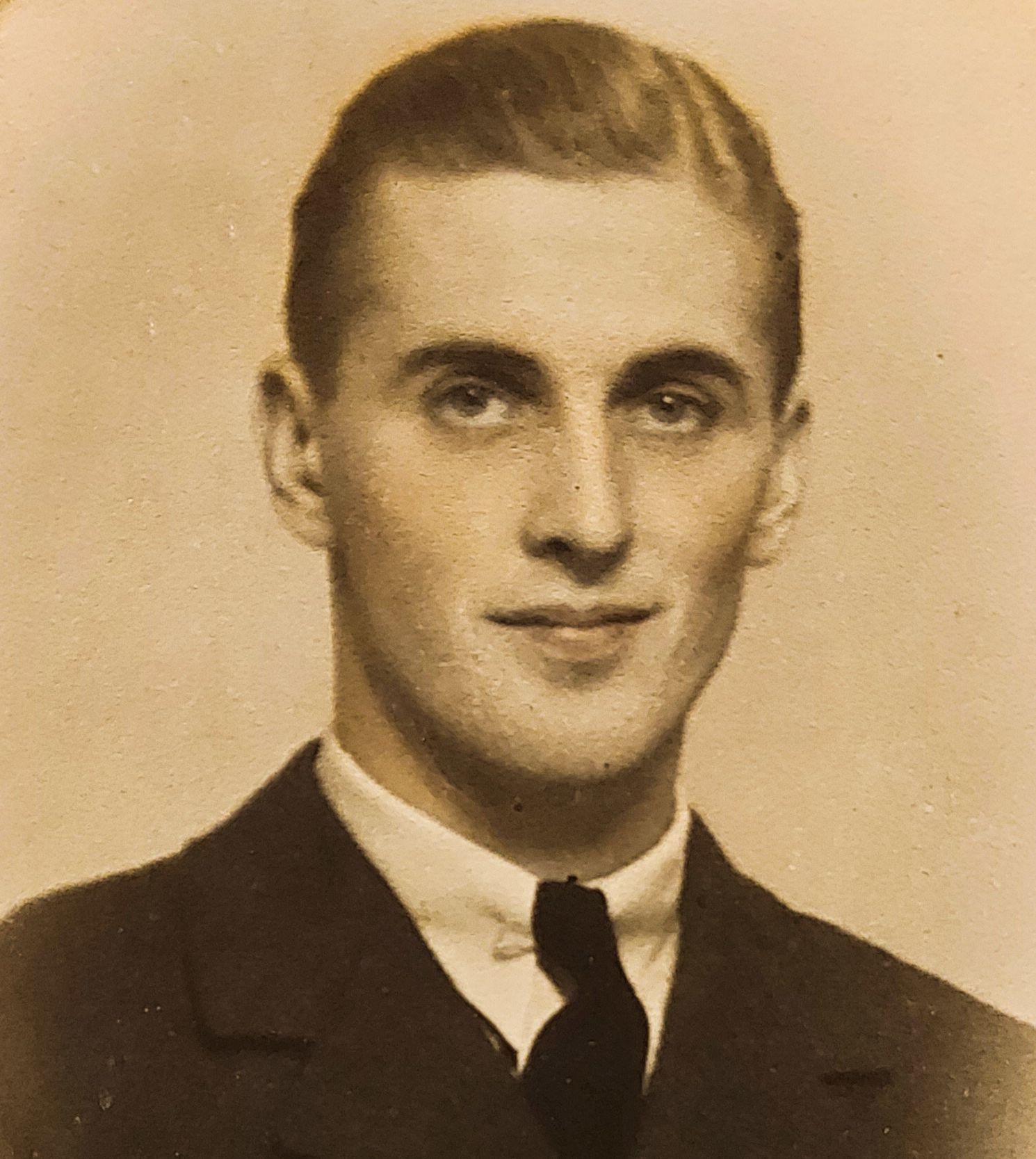
I baled out at 2350 hours on 7 August 1944 and landed in a field east of Drubec. I hid my parachute, harness and mae west in some bushes and ran west for about half an hour. I then slept in a field until dawn on 8 August when I began walking west across country. At 1800 hours I approached a farmer in a field and asked him for help. The remainder of my journey was arranged for me.
Gold ![]()
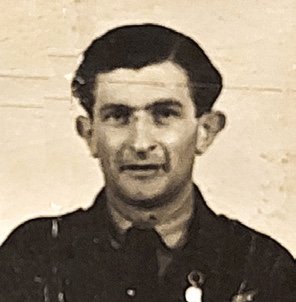
I baled out at 2350 hours on 7 August 1944 and landed in a field east of Bonnebosq. I was unconscious until approximately 1430 hours on 8 August. I hid my parachute, harness and mae west and starting walking west. At approximately 0700 hours I called at a farm on the outskirts of Bonnebosq and asked for help. The farmer gave me food and civilian clothes and I remained in a barn until midnight, when I began walking north-west across country. On 9 August about 0200 hours I went to sleep in a field until 0530 hours, when I again started walking north-west. About 0600 hours I called at a farm and asked for help. I was taken to a dugout about 200 yards from the house where I remained until the morning of 12 August. During this time I was fed and given a suit of overalls. The remainder of my journey was arranged for me.
The farm where I received help on 9 August 1944 was situated between Bonnebosq and Annebault. I met Jacques, a member of the resistance movement, at this farm. On 12 August at 0600 hours Jacques escorted me to Clarbec where we were met by a friend of Jacques who took me in a farm wagon to Blonville where I stayed at the post office which was kept by M. Vaillant. On arrival there I met Squadron Leader S. Laytal [Stanislaw H. Lapka], a Mustang pilot of the Polish Air Force and Lieutenant C. Blackwell , a fortress pilot of the USAAF [United States Army Air Force]. At 1800 hours my head was bandaged, although I was not injured, and I was escorted to Deauville by Marguerite, a friend of M. Vaillant. We travelled on bicycles. I was taken to a civilian hospital in Deauville and placed in a private ward, where I remained until 14 August, when I was escorted back to the post office by Marguerite. We again travelled on bicycles. Soon after my arrival back at the post office, Flight Sergeant Kiddie was brought to the house.
Squadron Leader Laytal [Lapka], Lieutenant Blackwell, Flight Sergeant Kiddie and I remained at the post office until 22 August when we were taken in a car by three members of the local maquis to Villers, where we contacted the British forces. We were sent to Bayeux, where I was briefly interrogated and sent to the UK by air.
Henderson ![]()
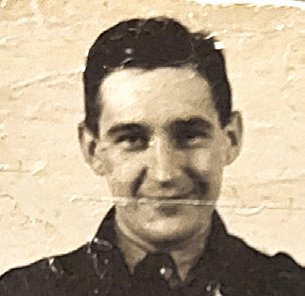
After baling out at 2350 hours on 7 August 1944 I landed in a tree near St Hymer. I could not free my parachute but I hid my mae west in a bush and walked south east for about 5 miles. I then hid in a hay wagon until dusk on 8 August when I walked south west until dawn on 9 August, when I hid in a haystack. About 0600 hours a Frenchman who was passing saw me. I left the haystack and hid in a nearby barn. About 1200 hours the Frenchman whom I had seen earlier came to the barn. I asked him for help and he went away and returned later with food. He told me that the British lines were about 25km distant. At dusk that evening (9 August) I started walking towards the British lines. I discovered that a large number of Germans were in the district, so I returned to the barn. I remained there until 22 August when I contacted a British tank unit. During the time I was in the barn the Frenchman supplied me with some food. After contacting the British forces I was briefly interrogated and sent to the UK by air.
Smith, Kiddie, Gold and Henderson were reunited on the same flight from Bayeux - B14 airstrip Banville - to London Northolt on 25 August 1944.
Cassell (POW number 86320) was interned at Stalag Luft 7, Bankau, near Kreuzburg, Upper Silesia. Reid (POW number 85894) was held at Stalag Luft 1, Barth, Western Pomerania.
LEONARD ARTHUR FRENCH - LIFE AND RAF CAREER
We know relatively little about Flight Lieutenant French. He was born in Wandsworth (London) on 14 May 1923 and in the 1939 England and Wales register for Merton and Morden, Surrey (south of London) is described as being “at school” and living at 22 Mossville Gardens with his mother Olive Irene French (née Landymore), age 39 and sister Irene B. French age 13, also “at school”. His father Hubert Arthur French (who married Olive at Wimbledon on 20 November 1922) is not listed at that address but in 1944 writes to Mrs Smith from Worcester. The marriage certificate describes him as a civil servant, while the 1939 England and Wales register more specifically lists him as an executive officer in the Air Ministry living at Tetbury, Worcestershire.
Leonard was 16 years old when war broke out in September 1939 and did not reach the age of 18 until May 1941 when he would have been old enough to join the armed forces. His service record shows that he enlisted on 1 September 1941.
Information about Leonard’s RAF career can be inferred from his service record (mentioning training in Canada) and from the logbook of Sergeant Gold. The logbook shows Gold and French passing progressively through No. 12 OTU (operational training unit) Edgehill (Oxfordshire) and Chipping Warden (Northamptonshire) in Wellington bombers, then No. 1651 conversion unit Wratting Common (Cambridgeshire) in Stirling aircraft, on to 90 Squadron Tuddenham still in Stirlings, with a course at No. 3 Lancaster finishing school at Feltwell (Norfolk), after which all their flights are in Lancasters.
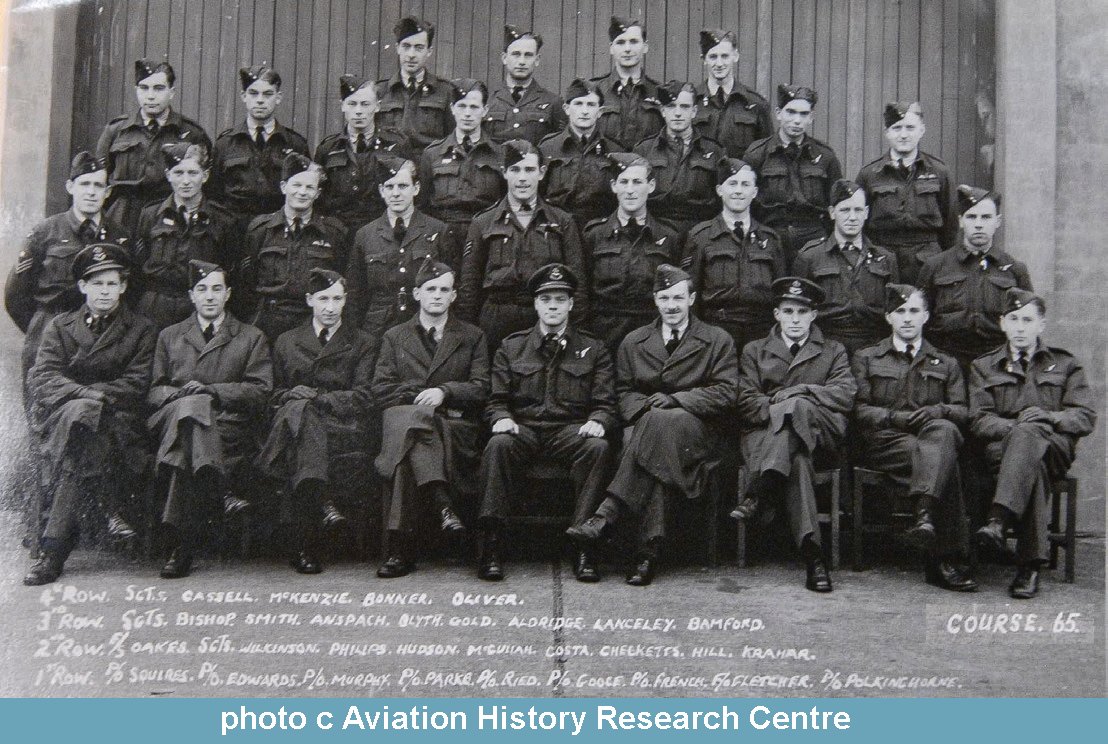 We also see how French progresses from trainee to operational pilot. He is first mentioned in the logbook on 26 November 1943 when rear gunner Sergeant Gold is on a training flight in a Wellington III bomber with Pilot Officer French and Flying Officer Goodman, presumably under the supervision of the latter. Gold’s logbook lists circuits, landings and exercises with Pilot Officer French (but also occasionally with Flying Officer Smith) in Wellington and Stirling bombers until 10 May. From 29 February French is promoted from pilot officer to flying officer. Then, from 14 May 1944 onwards we see Gold and French in actual operations involving mine-laying at Le Havre and La Rochelle as well as an air-sea rescue search.
We also see how French progresses from trainee to operational pilot. He is first mentioned in the logbook on 26 November 1943 when rear gunner Sergeant Gold is on a training flight in a Wellington III bomber with Pilot Officer French and Flying Officer Goodman, presumably under the supervision of the latter. Gold’s logbook lists circuits, landings and exercises with Pilot Officer French (but also occasionally with Flying Officer Smith) in Wellington and Stirling bombers until 10 May. From 29 February French is promoted from pilot officer to flying officer. Then, from 14 May 1944 onwards we see Gold and French in actual operations involving mine-laying at Le Havre and La Rochelle as well as an air-sea rescue search.
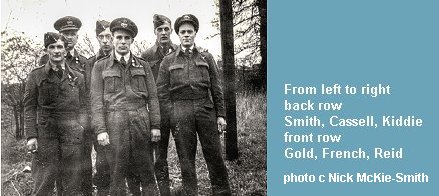 On 6 June 1944 at Feltwell Lancaster finishing school flying officer French performs circuits and landings in dual control with another pilot for the first time in a Lancaster and then an hour later goes solo.
On 6 June 1944 at Feltwell Lancaster finishing school flying officer French performs circuits and landings in dual control with another pilot for the first time in a Lancaster and then an hour later goes solo.
On 12 June Gold and French take part in an operation in a Lancaster against a synthetic oil plant at Gelsenkirchen. At the end of July French - now described in the logbook as flight lieutenant - and Gold are attacking a rocket site near Dieppe.
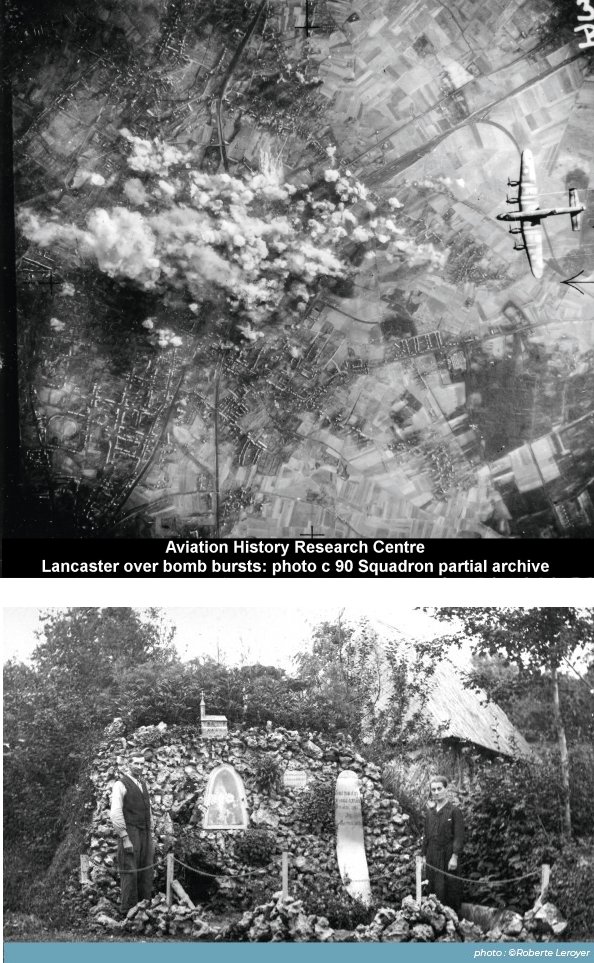 Then follow further operations against enemy shipping concentrations, marshalling yards, robot plane installations, oil refineries until the final logbook entry for 7 August 1944. This - in different handwriting from all the other entries - indicates “Mare de Magne near Caen, Nazi panzer concentrations - did not return”. The total number of combat operations in Sergeant Gold’s logbook carried out with French as pilot is 24, of which 21 were flown in a Lancaster.
Then follow further operations against enemy shipping concentrations, marshalling yards, robot plane installations, oil refineries until the final logbook entry for 7 August 1944. This - in different handwriting from all the other entries - indicates “Mare de Magne near Caen, Nazi panzer concentrations - did not return”. The total number of combat operations in Sergeant Gold’s logbook carried out with French as pilot is 24, of which 21 were flown in a Lancaster.
AFTER LIBERATION
Pont l’Evêque and the surrounding area - including Clarbec - were liberated by allied troops on 24 August 1944.In order to give thanks for his family’s having survived unharmed - M. Léon Leroyer, the owner of the farm next to the crash site, erected a shrine to the Virgin Mary incorporating a propeller blade and parts from the wreckage of the aircraft with the inscription “Tout près d’ici je suis tombé le 7 août 1944 - in memoriam”. Both the shrine and the grave are cared for and maintained with flowers by the local inhabitants and constitute important points of interest for visitors to Clarbec.
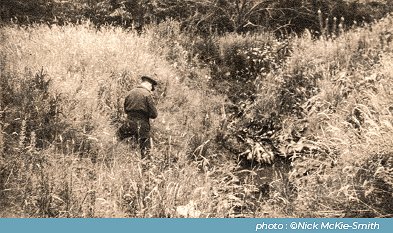 In July 1946 Flying Officer Smith revisited the site of the crash and the grave of his fellow crew member Flight Lieutenant French and took a photograph of the temporary white wooden cross. Over the following years he continued to visit Clarbec and his hiding place at the Manoir du Bois Simon at Auvillars and maintained a firm friendship with M. Roland Deliquaire of Bonnebosq who had given him such valuable help in 1944.
In July 1946 Flying Officer Smith revisited the site of the crash and the grave of his fellow crew member Flight Lieutenant French and took a photograph of the temporary white wooden cross. Over the following years he continued to visit Clarbec and his hiding place at the Manoir du Bois Simon at Auvillars and maintained a firm friendship with M. Roland Deliquaire of Bonnebosq who had given him such valuable help in 1944.
Irene French came to visit Clarbec in 1994. On her return to England she wrote to express her thanks to those responsible for keeping her brother’s grave well maintained, sending Leonard’s scroll of honour given to the family by the RAF. In her letter Irene wrote: “It has been a long time since my brother was killed and last year I felt I must visit his grave. Thank you for your kindness and tribute to those who died. We all have a lasting debt to them”.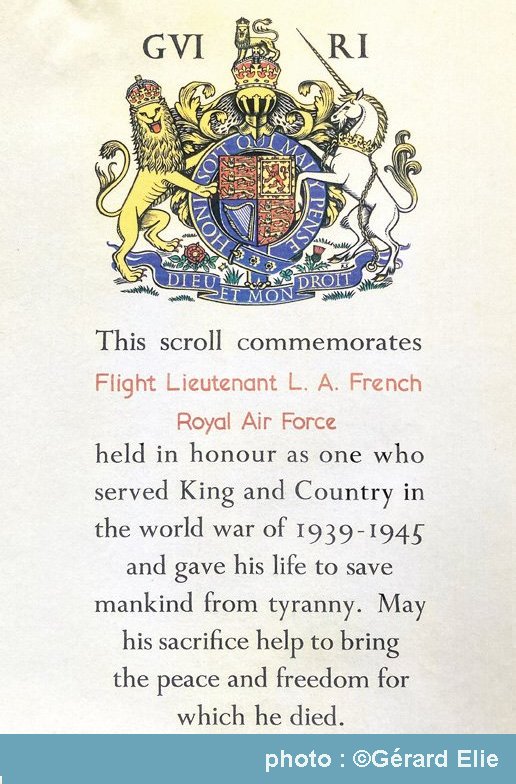
LOOKING BACK
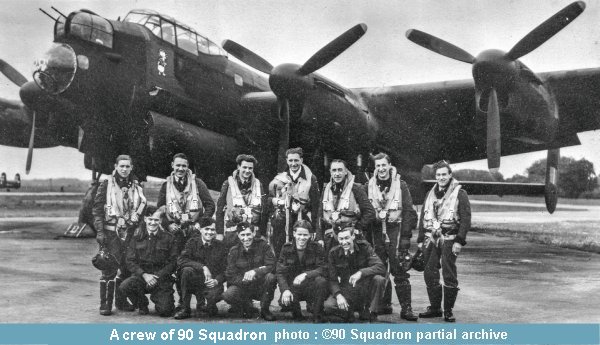 Operation Totalize was an offensive launched by Allied troops during the later stages of Operation Overlord, from 8 to 9 August 1944. The intention was to break through the German defences south of Caen on the eastern flank of the Allied positions in Normandy and exploit success by driving south, to capture the high ground north of the city of Falaise. The goal was to bring about the collapse of the German front and cut off the retreat of German forces fighting the Allied armies further west.
Operation Totalize was an offensive launched by Allied troops during the later stages of Operation Overlord, from 8 to 9 August 1944. The intention was to break through the German defences south of Caen on the eastern flank of the Allied positions in Normandy and exploit success by driving south, to capture the high ground north of the city of Falaise. The goal was to bring about the collapse of the German front and cut off the retreat of German forces fighting the Allied armies further west.
The Lancaster was the RAF’s most effective heavy bomber with four Rolls Royce Merlin engines and 3 gun turrets, carrying up to 22,000 lbs of bombs. French’s aircraft Avro Lancaster LM111 WP-G was built by Armstrong Whitworth and delivered to 90 Squadron on 20 May 1944. Bomber Command suffered the highest casualty rate of any branch of the British armed services in WW2 and on average Lancasters completed 21 missions before being lost.
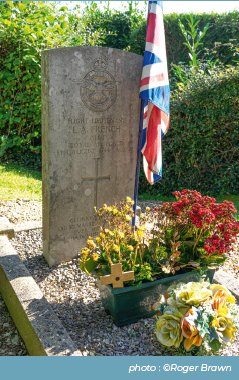
Flight Lieutenant French (Royal Air Force Volunteer Reserve, 90 Squadron - service number 144 954) who was 21 when he died, is buried in a Commonwealth War Grave in Clarbec church cemetery. For his bravery he was mentioned in dispatches in June 1946.
